Summer is coming, which means it’s time to plant potatoes. This cultivated plant is considered one of the most common in gardens and areas of our country. The distance between the rows of potatoes is very important for the future harvest. At the same time, do not forget that the distance between the potatoes should also be taken into account. These parameters play an important role in the formation of tubers. Therefore, this article will be devoted to these issues.
Distance between rows
To get a good potato harvest, when planting it, the distance between the rows, as well as the distance between the tubers, should be taken into account. It is necessary to start planting potatoes only when the soil temperature reaches up to 8 degrees at a depth of 10 cm. Often these conditions occur in May (during a dry and warm spring, planting can be done already at the beginning of this month).
You should know that well-sprouted tubers can be planted a little earlier – at a temperature of 5 or 6 degrees in the soil. Some gardeners claim that such planting, on the contrary, contributes to a higher level of yield.
Usually planting potatoes is carried out on a flat surface. But with heavy or waterlogged soils – on the ridges (beds). This allows the soil to warm up better, and also improves its aeration.
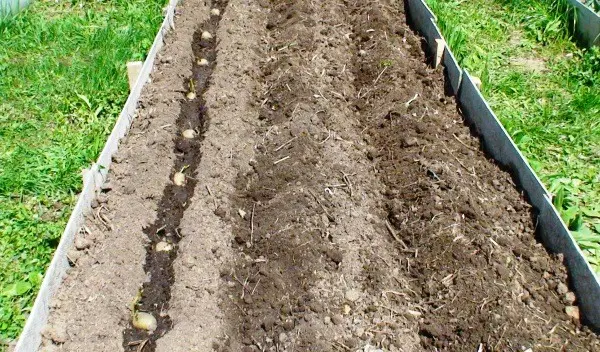
You need to start planting by determining the distance between the rows. To do this, do the following:
- mark the entire area;
- marking is done with a marker (in this case, this means a shovel, stick, etc.). They draw a shallow furrow. On these furrows and carry out further landing;
- a cord is pulled along the first furrow between the wedges, which will act as a guide;
- the tuber can be planted directly under the stretched cord. But this is a very laborious process that will take a lot of time;
- after planting potatoes in a row, to increase productivity, the soil should be mulched. Mulching is carried out with peat, which is poured in a layer of two to three centimeters.
If a ridge planting option is used (beds are formed), then two rows are placed in one bed. In this situation, the rows are placed at a distance of 19-26 cm. Each subsequent two rows are separated by a groove having a width of one shovel. The walls of this groove should be sloping.
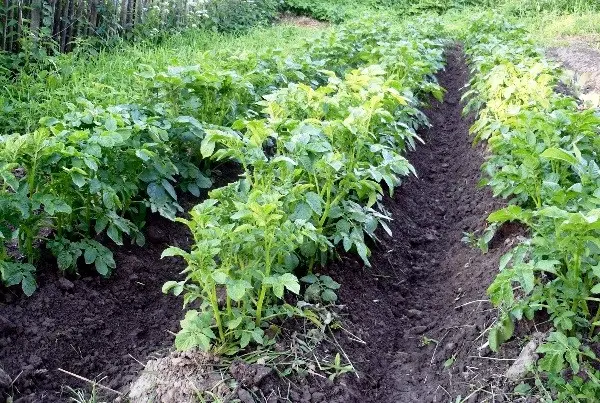
The best distance between two adjacent rows for potatoes is determined by its variety:
- early ripe varieties should be grown at a distance of 60-75 cm;
- late-ripening varieties should be planted in a row, the distance between which should be no more than 90 cm (minimum 70 cm).
Planting potatoes in a row is usually carried out according to the 30×80 cm pattern. Here, an adjustment should be made for the plant variety. Early potatoes form less dense haulm, so they can be planted more densely with smaller row spacings. Some gardeners claim that the simultaneous planting of early and late varieties will give a better harvest.
Rows should be oriented from north to south. This will give the bushes more sunlight. Although in this situation it is possible to be guided by the capabilities of your site or garden and determine the distance by eye.
Spacing between tubers
If we dealt with the distance between rows in the previous paragraph, then the question of the optimal distance between tubers remains open.
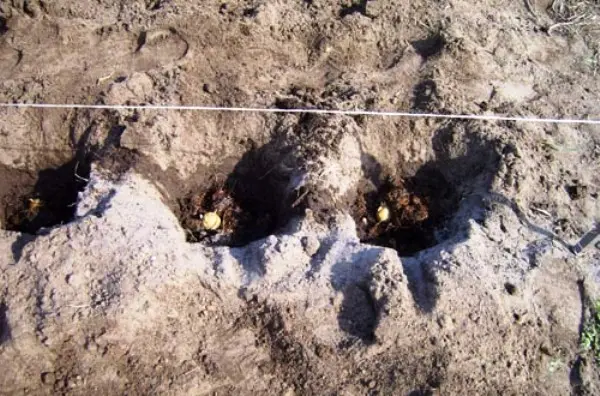
Most often in the literature you can find the statement that about 6 bushes should be planted per square meter. If we take just such a number of plants, then in the case of a row spacing of about 70 cm, it is necessary to maintain a distance between the bushes of 26 cm. In practice, in order not to run with a ruler, this distance practically corresponds to a segment of one and a half width of an ordinary shovel. You should be guided by the diameter of the hole dug with such a shovel (it is approximately 25-27 cm).
But when using such a planting scheme, the potatoes will grow quite densely. This option is not very profitable in terms of plantation yield. In practice, this scheme is rarely used.
More often you can find a landing where the gaps between the bushes will be twice as large. You can also find the following method for calculating the correct distance between the bushes. Here, the total weight of the potato must be divided by the entire area on which you plan to plant it. In this case, the figures obtained will be a real reflection of the yield. You can even find data when the distance between the holes is one meter (for row proximity of 70 cm). But this method gives the smallest yield.
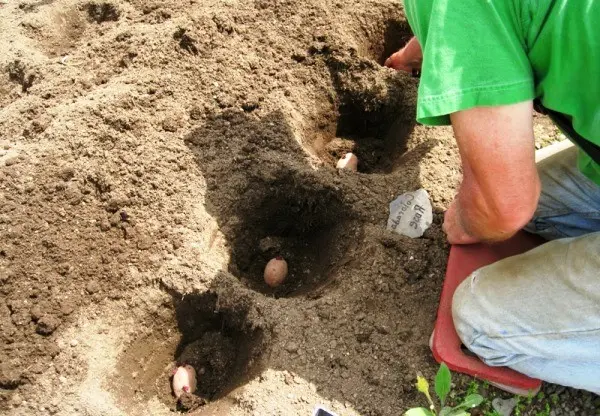
It should be noted that, as in the situation with the distance between the rows, it is necessary to take into account the plant variety:
- early varieties are best planted at a distance between bushes from 25 to 30 cm;
- late varieties need to be planted at a greater distance – from 30 to 35 cm.
These figures are for tubers that have a standard size for planting (with a chicken egg). When using smaller tubers, the above distances must be reduced. The optimal distance will be about 18-20 cm. For very large tubers, the distance can increase significantly and even be 45 cm.
The distance that is observed for the rows is not of particular importance when choosing the distance between the bushes. This parameter is directly dependent on the characteristics of the soil composition. If the soil is fertile, there are a lot of nutrients in it, then the planting should be carried out more densely, since the possibilities of the soil will allow the bushes to form normally and give an excellent harvest in terms of taste and volume. With low soil fertility, gardeners recommend planting tubers at a greater distance from each other, so that in the future the bushes have enough opportunities to form a crop.

Common potato planting pattern
Tubers are planted in holes. The correct depth for them is from 7 to 10 cm. At this depth, the potatoes warm up best and germinate quickly. Sprouted stalks should be covered with earth on top. This procedure will need to be repeated in a week. This will allow the formation of strong stems, which will positively affect the yield. If the planting dates were later, then the depth of the hole increases by 3 cm (especially this rule applies to dry periods).
Also, the depth of the hole depends on the type of soil. For heavy soil, this parameter should be about 8 cm. In light soils, the depth of the hole should be about 10 cm. And for clay soils, the hole is made with a depth of 5 cm.
When choosing a depth, you should not clearly focus on the above figures, since you need to make an assessment of the size of the tubers themselves. Smaller potatoes need to be planted at a shallow depth, but for large ones, the depth should be greater. A deviation from the established figures by no more than 3 cm in any direction is allowed.
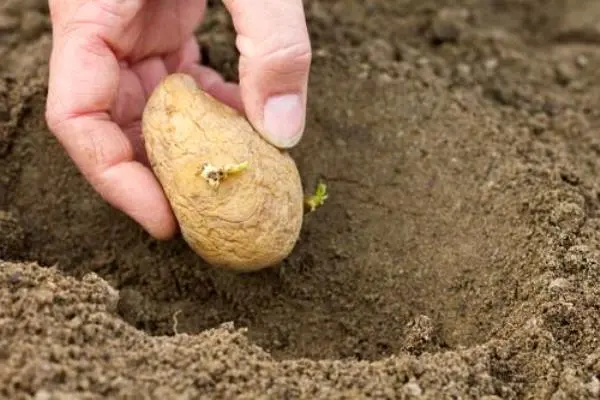
It is recommended to plant tubers in the holes with sprouts down. This must be done in order to form a better spreading, which will contribute to greater ventilation and illumination of the resulting bush. After this procedure has been completed, and all the rules have been followed, with the help of a rake, you should cover the potatoes with earth from above.
As you can see, such a seemingly ordinary process as planting potatoes can be a certain degree of complexity. Incorrectly planted tubers can significantly reduce the yield of an entire plantation. Therefore, before proceeding with the process itself, you should first familiarize yourself with the nuances that relate to this issue.
Video “How to plant potatoes”
In the video, the agronomist tells how to plant potatoes correctly: when to plant, which planting scheme to choose depending on the type of soil; different landing schemes are considered.









